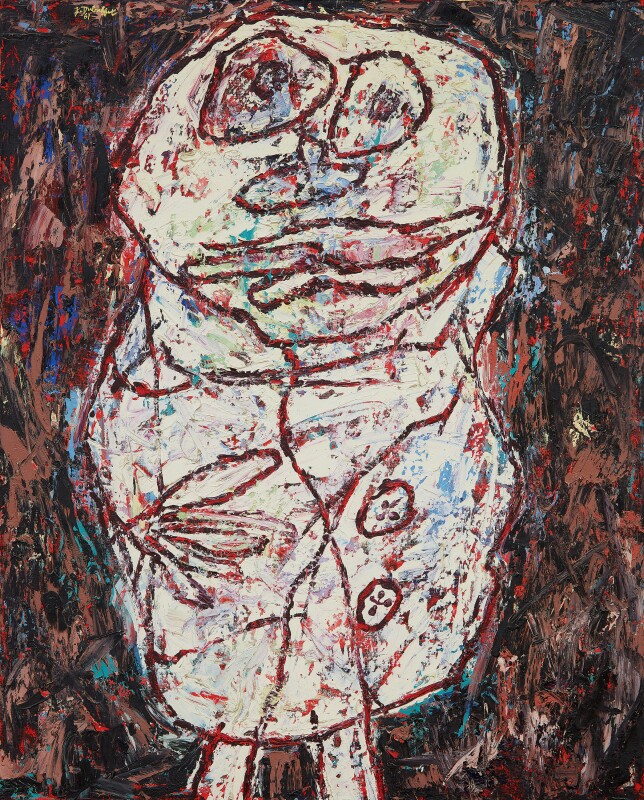"Jean Dubuffet has shed his ground-worshipper tunic. The period of austerity is over. His ‘matériologue’ side sleeps; make way for the playful and theatrical Janus, the dancer and shouter.”
E xecuted in September 1961, this painting dates from the brilliant creative inception of Jean Dubuffet’s most illustrious and sought-after series: the vibrant canvases of the Paris Circus.
Broadly divisible into three distinct tranches – Parisian street scenes bustling with small figures, cars and shopfronts; cellular figurative compositions that prefigure the Hourloupe cycle; and groups of one or two larger figures isolated within the hubbub of Parisian life – works from this pivotal period are housed in numerous major international collections worldwide, including the Tate Modern, London, the Solomon R. Guggenheim Museum, New York, the National Gallery of Art, Washington, D.C, and the Centre Georges Pompidou, Paris.
Hailing from the esteemed collection of George S. Rosenthal and his wife Jean, within whose family it has remained since its acquisition only three months after it was painted in 1961, Mélancolie is a superb and heavily worked example of this third group, with layers of white and black paint pulled away to reveal jewel-like shots of colour. One arm raised to cover his mouth, perhaps in reference to the traditional depictions of melancholy by Albrecht Dürer and Edvard Munch, and the other pinned to his side, the present figure suggests a self-portrait that reflects the mild panic that Dubuffet must have felt when he returned to the capital from the countryside, finding there a city entirely different from the one he had left in 1955.
Six years earlier, seeking to escape the scarred and battered atmosphere of post-war Paris, Dubuffet had transported his life and practice to Vence, where his focus shifted to a dark, rural aesthetic of earthy materials and roughly hewn tactility. Shunning human subjects, the Topographies, Texturologies, and Matériologies of the late 1950s sought refuge in material immediacy and geological explorations of the soil that retreated from the calamitous effects of the Second World War. Returning to Paris in 1961 however, Dubuffet found a city that had cast off the post-war gloom, teeming with people, energy and colour. The Paris Circus cycle is a response to this brave new world; where he had previously sought to elevate the minute and natural, now Dubuffet celebrated the technicolour expanse of human civilisation.
Max Loreau, the preeminent scholar of the artist’s work and editor of his catalogue raisonné, observes of this transition: “Jean Dubuffet has shed his ground-worshipper tunic. The period of austerity is over. His ‘matériologue’ side sleeps; make way for the playful and theatrical Janus, the dancer and shouter” (Max Loreau, Catalogue des travaux, Fascicule XIX, Paris-Circus, Paris 1965, p. 7). Most noticeably, these new works saw Dubuffet populate his canvases with human figures, anonymous civilians in the case of the street scenes, but often self-portraits as well, as the present work perhaps suggests.
Contrasting these works with those that came before, Dubuffet observed: "The principle thing about [my recent paintings] is that they are in complete contrast to those of the Texturology and Materiology series that I did previously. They are in every way the opposite… In reaction against this absenteeist tendency my paintings of this year put into play in all respects a very different intervention. The presence in them of the painter now is constant, even exaggerated. They are full of personages, and this time their role is played with spirit'' (Jean Dubuffet, ‘Statement on Paintings of 1961’ cited in: Peter Selz, The Work of Jean Dubuffet, New York 1962, p. 165).
Synonymous with other paintings from the Paris Circus cycle, Mélancolie sees Dubuffet utilise bright blues, pinks and reds to conjure the vitality of the city, and yet he retains the heavy texture of his Texturologies and Matériologies. The composition and subject also recall Dubuffet’s celebrated sequence of proto-self portraits from 1954, where the artist painted himself in the role of characters from the French countryside encountered on his regular trips from Paris to Clermont-Ferrand, such as Le Planteur (The Sower), and Le Chevalier de Nuit (The Night's Horseman). However, it is notable that unlike many of the pieces from the Paris Circus series, for which Dubuffet unconditionally embraced the joyous vitality of the city, he is portrayed here wide-eyed and closed in posture, with his cardigan buttoned tightly around him as an individual thrust into the urban metropolis for the first time. Joyful colours and shapes abound, but the figure appears overwhelmed by this sensory overload, retreating into himself.







